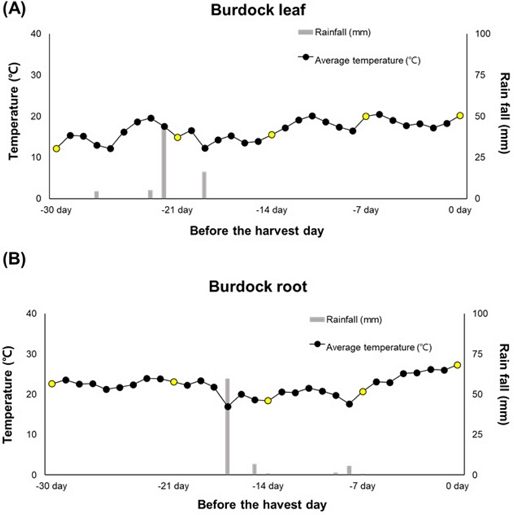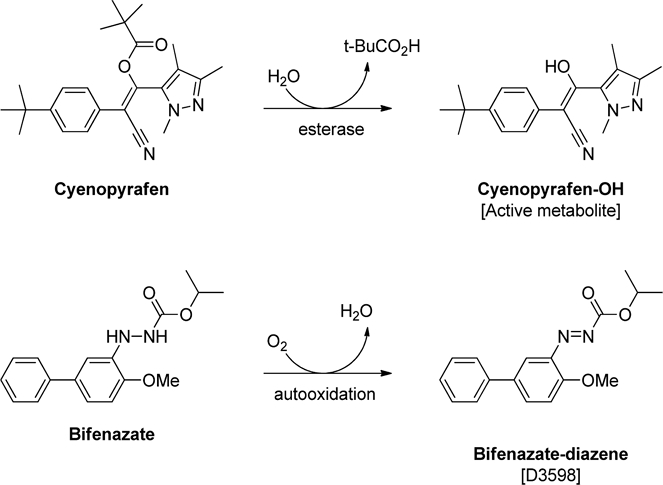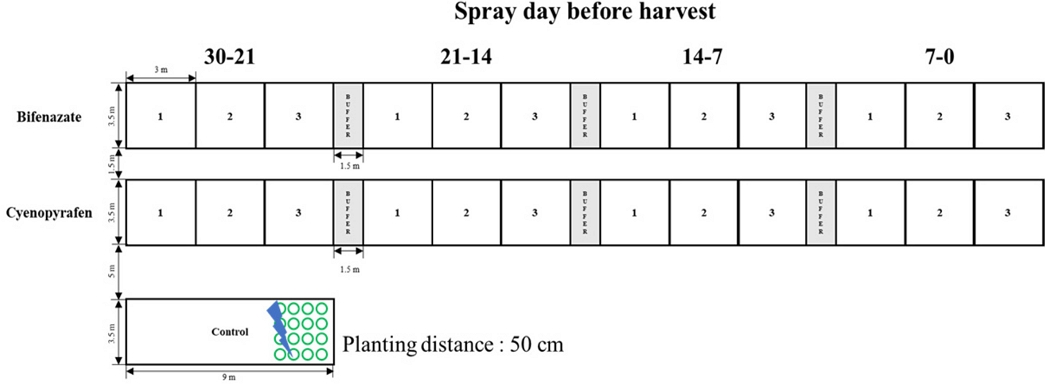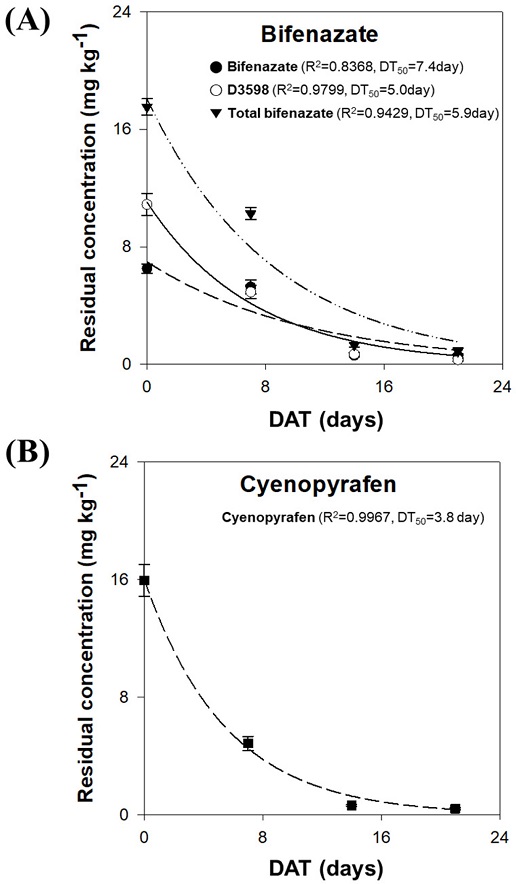
차응애 방제를 위한 Bifenazate와 Cyenopyrafen 액상수화제의 우엉의 잎과 뿌리 중 잔류변화 및 식이섭취 노출 안전성 평가
 ; Deuk-Yeong Lee1
; Deuk-Yeong Lee1 ; Sung-Jun Seo1
; Sung-Jun Seo1 ; Sang-Woo Kang1
; Sang-Woo Kang1 ; Jin-Seong Kim1
; Jin-Seong Kim1 ; Young-Jin Kim1, 2
; Young-Jin Kim1, 2 ; Jin-Hyo Kim1, *
; Jin-Hyo Kim1, *
초록
23.5% bifenazate SC와 25% cyenopyrafen SC를 우엉 노지 재배지에 살포하여 우엉 뿌리와 잎에서의 경시적 잔류변화와 작물 잔류 반감기(DT50) 및 잔류안전성을 평가하였다. 주요 가식부인 우엉 뿌리에서는 모든 처리구에서 bifenazate와 cyenopyrafen 이 모두 0.01 mg kg-1 미만으로 불검출 되었다. 따라서, 23.5% bifenazate와 25% cyenopyrafen SC의 우엉 뿌리에 대한 안전사용기준은 수확 7일전까지 2000배 희석액에 한하여 7일 간격 2회 처리가 가능할 것이다. 우엉 잎에서 bifenazate의 총 환산 잔류량은 수확 당일 약액 살포 후 17.5 ± 0.56 mg kg-1이었고, 최종 약제 처리 21일 경과 후 잔류량은 0.893 ± 0.216 mg kg-1으로 감소함을 확인하였다. 우엉 잎에 대한 bifenazate의 DT50은 5.9일이었다. 수확 당일 약액 살포 후 우엉 잎에서 cyenopyrafen의 초기 잔류량은 16.0 ± 1.09 mg kg-1이었고, 최종 약제 처리 21일 경과 후 잔류량은 0.426 ± 0.061 mg kg-1으로 감소하였다. 이는 현재 엽채류에 대해 설정 되어있는 MRL인 5.0 mg kg-1을 초과하지 않았다. 우엉 잎에서 cyenopyrafen의 DT50은 3.8일이었다. 23.5% bifenazate와 25% cyenopyrafen SC의 우엉 잎에 대한 안전사용기준은 수확 14일전까지 2000배 희석액을 사용하여 7일간격 2회 처리를 고려해 볼 수 있을 것이다.
Abstract
Bifenazate and cyenopyrafen are known as active ingredients for tea spider mites (Tetranychus kanzawai) but are not registered for burdock. In this study, we investigated the time-course residue dissipation and the residue safety of bifenazate and cyenopyrafen on burdock roots and leaves through an open-field trial. The 23.5% bifenazate (SC) and 25% cyenopyrafen (SC) were applied twice at 7-day intervals with 2000-fold diluted solutions. The residues of bifenazate and cyenopyrafen in burdock roots were not detected (<0.01 mg kg-1). Otherwise, the initial residue of total bifenazate in the leaves was 17.5 ± 0.56 mg kg-1, and it decreased to 0.893 ± 0.216 mg kg-1 on 21 days after treatment (DAT). The initial residue of cyenopyrafen in the leaves was 16.0 ± 1.09 mg kg-1 and decreased to 0.426 ± 0.061 mg kg-1 on 21 DAT. The calculated DT50s of bifenazate and cyenopyrafen in the leaves were 5.9 and 3.8 days, respectively.
Keywords:
Burdock, Bifenazate, Cyenopyrafen, Dissipation time, Residual safety키워드:
비페나제이트, 사이에노피라펜, 잔류 반감기, 잔류안전성, 우엉서 론
작물에 대한 소비자의 관심으로 소면적재배 작물의 종류와 면적은 지속적으로 증가하고 있으나, 소면적 작물의 재배 기술이 확립되어 있지 않고, 등록 농약 수가 제한되어 있어 병해충 발생 시 피해가 심각한 실정이다(Kim et al., 2012; Son et al., 2012; Kim et al., 2017a; Abou Zeid et al., 2021; Oh et al., 2022). 이에 따라, 소면적 작물에 등록된 약제의 저항성 발현 억제와 병해충 방제 효율 증진을 위해 다양한 유효성분을 대상으로 농약등록 시험과 연구가 필요하다(Kim et al., 2021; Oh et al., 2021; Lee et al., 2022).
우엉(Arctium lappa L.)은 국화과의 두해살이 풀로 국내에서 재배면적은 142 ha이며, 경상남도를 중심으로 일부 지역에서 재배되는 소면적 재배작물로서(KOISIS, 2023), 어린 잎과 뿌리를 식용으로 하며, 뿌리는 고혈압, 통풍, 심혈관질환, 간암, 항암, 항노화 등의 항산화 기능이 있는 것으로 알려져 있다(Kim et al., 2014a; Kim et al., 2014b; Lee, 2011). 현재 우엉의 병해충 방제에 등록되어 있는 유효성분은 갈색무늬병과 거세미나방, 차응애 등 14종의 병해충에 대해 abamectin과 tebuconazole, chlorfenapyr 등 49종이 등록되어 있다(KCPA, 2022). 이들 중 차응애 방제를 위해 등록된 유효성분은 abamectin 1종으로, 사용가능한 등록 농약의 수를 늘리기 위한 연구가 필요하다(Kim et al., 2021; Oh et al., 2022; KCPA, 2022).
국내에 가지, 들깨 등 타작물의 차응애 방제를 위해 등록된 유효성분은 abamectin과 bifenazate, cyenopyrafen 등 31종이 있다(KCPA, 2022). 이들 중 bifenazate와 cyenopyrafen은 각각 전자전달계의 미토콘드리아 복합체 III와 복합체 II의 전자전달을 저해하는 작용기작이 알려져 있다(IARC, 2023). Bifenazate는 미토콘드리아 복합체 III의 cytochromeb의 Q0에서 전자전달을 저해하며, 이와 유사한 작용기작을 갖는 약제로는 acequinocyl과 fluacrpyrim, hydramethylnon 등이 있다(Van Nieuwenhuyse et al., 2012; Bian et al., 2022; IRAC, 2023). Cyenopyrafen은 β-ketonitrile 유도체로 미토콘드리아 복합체 II (Succinate dehydrogenase)의 전자 전달을 저해하며, 동일 기작을 갖는 약제로는 cyflumetofen과 pyflubumide 등이 있다(Sugimoto et al., 2020; IARC, 2023). 이와 같이 bifenazate와 cyenopyrafen은 차응애 방제에 약효가 기대되지만, 우엉에 대한 작물 잔류안전성이 검증되지 않아 농약안전사용기준과 최대잔류허용기준(maximum residue limit, MRL)에 대한 평가가 부족하였다.
Bifenazate는 국내에서 23.5% 액상수화제(suspension concentration, SC)로 등록되어 있으며, 감귤, 사과, 아로니아, 셀러리 등 19작물의 응애류 방제에 등록되어 있다(KCPA, 2022). Bifenazate의 잔류분 정의는 농촌진흥청의 “농약의 잔류분 정의” 지침에 따르면, 모화합물인 bifenazate와 이의 대사체인 bifenazate-diazene (D3598)의 환산잔류량으로 잔류분을 정의하고 있다. Bifenazate의 만성 독성시험결과 최대 무독성용량(No observed adverse effect level, NOAEL)은 쥐에서 1.0 mg kgbw-1day-1이었고, 이를 통해 산출한 1일 섭취허용량(Acceptable daily intake, ADI)은 0.01 mg kgbw-1 day-1이었다(MFDS, 2023). Cyenopyrafen은 전구적 살응애제 형태로 알려져 있으며, 체내 esterase에 의해 가수분해된 cyenopyrafen-OH도 미토콘드리아 복합체 II 저해작용이 있는 것으로 알려져 있다(Hayashi et al., 2012; Sugimoto and Osakabe, 2014; Khalighi et al., 2016) (Fig. 1). 하지만, cyenopyrafen-OH는 포유동물에 대한 독성(LD50 >2000 mg kg-1)과 미토콘드리아 복합체 저해활성이 높지 않은 것으로 알려져 있어(Hayashi et al., 2012), 독성 잔류분 정의에는 모화합물인 cyenopyrafen으로 정의되어 있으며, 25% SC로 겨울배추검정응애와 귤응애, 사과응애, 점박이응애, 차먼지응애, 차응애 등의 방제에 등록되어 있다(KCPA, 2022). Cyenopyrafen의 만성 독성시험 결과 NOAEL은 쥐에서 5 mg kgbw-1 day-1이었고, 이를 통해 산출한 ADI는 0.05 mg kgbw-1 day-1이었다(MFDS, 2023).
본 연구에서는 우엉의 차응애 방제를 위한 23.5% bienazate SC와 25% cyenopyrfen SC의 작물 잔류 안전성을 검토하고자 이들 약제의 경시적 잔류변화와 잔류 반감기를 평가하였다.
재료 및 방법
표준품 및 시약
분석용 표준품은 Sigma-Aldrich® (Merck KGaA, Darmstadt, Germany)에서 bifenazate (99.2%)를 구입하여 사용하였고, bifenazate의 대사체인 bifenazate-diazene (D3598, 97.3%)과 cyenopyrafen (99.9%)의 분석용 표준품은 HPC Standards GmbH (Borsdorf, Germany)에서 구입하여 사용하였으며, 시험대상 성분의 이화학적 특성은 Table 1과 같다. 분석용 용매인 acetonitrile (ACN)과 methanol, water는 Burdick & JacksonTM (Honeywell International Inc, Morris Plains, NJ, USA)의 high-performance liquid chromatography (HPLC) grade를 사용하였고, ammonium formate (Kanto Chemical Co., Inc., Tokyo, Japan)와 formic acid (Merck KGaA, Darmstadt, Germany)는 순도 >98%를 사용하였다. 우엉 뿌리와 잎 중 잔류 농약 추출에 사용한 roQTM QuEChERS kit (magnesium sulfate 4 g, sodium chloride 1 g, sodium citrate dibasic sesquihydrate 0.5 g, sodium citrate tribasic dihydrate 1 g)는 Phenomenex Inc. (Torrance, CA, USA)의 제품을 사용하였고, 추출시료의 정제를 위한 dispersive-solid phase extraction (d-SPE)는 primary-secondary amine (PSA) 25 mg과 C18 25 mg 및 MgSO4 150 mg으로 구성된 Agilent Technologies, Inc. (Santa Clara, CA, USA)의 d-SPE kit를 사용하였다.
시험포장 및 약제 처리
우엉의 잔류성 시험은 경상남도 진주시 지수면에서 수행하였으며, 우엉 잎의 잔류시험은 4월부터 5월까지 실시하였고, 우엉 뿌리의 잔류시험은 5월부터 6월까지 실시하였다. 전체 시험기간 동안 시험포장의 일일 평균 온도는 12.2-27.3oC이었고, 일 최대 강수량은 59.6 mm이었다(Fig. 2). 우엉의 품종은 유천이상(Kyoungshin Seeds Co. Ltd. Uiseng, Korea)을 사용하였다. 우엉 잎과 뿌리에 대한 잔류시험포장의 반복구는 각각 10.5 m2 (3.0 m × 3.5 m)로 조성하여 대조구와 시험구별 3반복 배치하였고, 약제는 7일간격 2회 살포하였다. 일시수확 작물의 특성을 반영하여, 시험구는 최종약제 처리일을 기준으로 수확 21일전, 수확 14일전, 수확 7일전, 수확당일 처리구로 구분하였으며, 시험구간의 약제 교차 오염을 방지하기 위해 완충구를 1.5 m 이상 두었고, 각 처리구에는 3반복 시험구를 두었다. 시험포장내 우엉은 각각 약 50 cm 간격으로 재식 하였다(Fig. 3). 우엉 뿌리 및 잎에 대한 bifenazate의 잔류시험은 23.5% SC ( yngenta Co. Ltd, Iksan, Korea)를 사용하였고, cyenopyrafen의 잔류시험은 25% SC (HankookSamgong Co. Ltd, Iksan, Korea)를 사용하였다. 시험농약은 수확 전 처리일을 달리하여 4개의 약제처리구를 설정하였고, bifenazate와 cyenopyrafen 2,000배 희석액을 충전식 분무기로 각 시험구 전체에 약액이 충분히 흐를 정도로 균일하게 살포 후 일시 수확하였다. 잔류분석을 위한 우엉 뿌리는 수확 당일 반복구당 2.0 kg 이상 수확하였으며, 우엉 잎은 1.0 kg 이상 수확하였다. 수확한 시료는 냉장상태로 실험실로 옮긴 후 드라이아이스와 함께 곱게 분쇄하고 잔류분석 전까지 –20oC서 보관하였다.

Weather condition for bifenazate and cyenopyrafen residue field trials on burdock root and leaf (Arctium lappa L.).
잔류분석 시료 전처리
Bifenazate와 D3598, cyenopyrafen의 잔류분석을 위한 시료의 전처리는 균질화 한 우엉 뿌리 및 잎 시료 10 g에 ACN 10 mL를 가한 후 roQTM QuEChERS kit를 첨가하여 30분간 200 rpm에서 진탕 추출하고, 15분간 초음파 추출(Powersonic 410, Hawshin Tech Co., Ltd., Seoul, Korea)하였다. 추출시료는 4oC, 4000 rpm에서 10분간 원심분리(LABOGENE 1580R, LabogenTM, Bio-Medical Science Co., Ltd., Seoul, Korea)하고, 상등액 1 mL를 취하여, d-SPE kit (PSA 25 mg, C18 25 mg, MgSO4 150 mg)에 넣고 3분간 vortexing한 후 syringe filter (PTFE, 0.22 μm, BIOFACT Co., Ltd., Daejeon, Korea)로 여과하였다. Bifenazate와 D3598, cyenopyrafen의 여과액은 ACN으로 10배 희석하여 잔류분석용 시료로 제조하였다. 분석 시료 중 표준검량선의 정량 범위를 초과한 시료는 무처리 추출물 10배 희석액을 이용하여 희석 후 분석하였다.
기기분석 조건
우엉 뿌리와 잎 중 bifenazate와 D3598, cyenopyrafen의 잔류분석은 LC-MS/MS (LC-MS 8050 Triple Quadrupole, Shimadzu, Kyoto, Japan)를 사용하여 Table 2의 조건에 따라 분석하였다. 이동상 용매는 5 mM ammonium formate를 포함한 0.1% formic acid 수용액과 5 mM ammonium formate와 0.1% formic acid를 포함한 methanol을 사용하였고, Phenomenex Inc. (Torrance, CA, USA)의 Kintex C18 (2.1 × 100 mm, 2.6 μm) 칼럼을 사용하여 분리하였다.
분석법 검증
검량선 작성을 위해 bifenazate, 이의 대사체인 D3598과 cyenopyrafen은 100 mg L-1 stock solution을 제조한 후 무처리 우엉 뿌리 및 잎 시료의 추출물을 사용하여 matrix matched 표준용액을 제조하였으며, 검량선은 0.0005-0.0500 mg L-1의 범위에서 작성하였다. 이들 성분의 matrix matched 표준용액은 시료 분석 전후로 2회 분석하여 검량선을 작성하였다. 정량한계(limit of quantitation, LOQ)는 signal/noise비 10이상을 기준으로 산출하였고(Lee et al., 2021), 분석법상 정량한계(Method Limit of Quantitation, MLOQ)는 아래의 Eq. 1과 같이 산출하였다. 회수율 시험은 모두 3반복 실시하였으며, 우엉 뿌리 중 회수율 시험은 0.01 mg kg-1과 0.1 mg kg-1에서 수행하였고, 우엉 잎 중 회수율 시험은 0.010 mg kg-1과 10 mg kg-1에서 수행하였다. 회수율 시험 중 처리 수준이 표준검량선의 범위를 초과하는 시료는 무처리 추출물 10배 희석액을 이용하여 희석 후 기기분석 하였다.
| (Eq. 1) |
Bifenazate의 총 환산잔류량
대사체를 포함하는 농약의 유효성분인 bifenazate의 총 환산잔류량은 농촌진흥청의 “농약의 잔류분 정의” 지침에 따라 산출하였다(NAS, 2018) (Eq. 2).
| (Eq. 2) |
잔류 반감기 산출
약제 처리 후 경과일수에 따른 작물 중 잔류량 변화에 대한 회귀식을 Eq. 3에 적용하여 잔류량 감소상수(k)를 산출하였다(Lee et al., 2022). Eq. 3에서 C0는 농약의 초기농도(mg kg-1), t는 경과시간, Ct는 t시간 후 농약의 농도(mg kg-1)를 나타낸다. 작물 잔류 반감기(Dissipation time, DT50)는 산출한 감소상소를 Eq. 4에 적용하여 산출하였다(Oh et al., 2022).
| (Eq. 3) |
| (Eq. 4) |
잔류 안전성 평가
Bifenazate와 cyenopyrafen의 잔류 안전성 평가를 위한 이론적 1일최대섭취량(Theoretical maximum daily intake, TMDI)은 식품의약품안전처(Ministry of Food and Drug Safety, MFDS)의 잔류물질정보에 등록되어 있는 MRL과 2020년 국민영양통계 중 전체 연령의 평균 체중(62.7 kg) 및 식품별식이 섭취량 자료를 Eq. 5에 적용하여 산출하였다(KHIDI, 2020; MFDS, 2023). 산출한 TMDI와 MFDS의 잔류물질정보에 등록되어 있는 1일섭취허용량(Acceptable daily intake, ADI)를 Eq. 6에 적용하여 %ADI를 산출하였다(Lee et al., 2021).
| (Eq. 5) |
| (Eq. 6) |
결과 및 고찰
분석법 검증
우엉 뿌리 및 잎 중 bifenazate와 이의 대사체인 D3598, cyenopyrafen의 잔류분석을 위한 검량선의 직선성(R2)은 모두 0.998 이상으로 양호하였고, 우엉 뿌리와 잎 중 분석대상 성분의 MLOQ는 모두 0.01 mg kg-1이었다(Table 3). Bifenazate와 D3598, cyenopyrafen의 회수율 시험 결과 우엉 뿌리에서 평균 회수율은 각각 81.5-109.5%이었고, 우엉 잎에서의 평균 회수율은 90.7-97.8%이었으며, 이들 정량분석에 대한 변이계수(Coefficient of variation, CV)는 0.5-6.3%이었다.
우엉 중 bifenazate의 경시적 잔류 변화와 잔류 반감기
23.5% Bifenazate 2,000배 희석액을 7일간격 2회 살포 후 우엉 뿌리와 잎에서 bifenazate의 잔류량을 조사하였다. 우엉 뿌리에서 bifenazate와 이의 대사체인 D3598은 모든 처리구에서 LOQ (0.01 mg kg-1)미만으로 불검출 되었다. 우엉잎에서 수확 당일 약액 살포 후 bifenazate의 초기 잔류량은 6.53 ± 0.325 mg kg-1이었고, 대사체인 D3598의 초기 잔류량은 10.9 ± 0.747 mg kg-1이었다(Fig. 4). D3598은 bifenazate의 hydrazinecarboxylic acid의 proton이 쉽게 autooxidation 되어 생성되며, 이는 biological metabolite가 아니므로 흔히 관찰된다(WHO, 2008; Bian et al., 2022). 우엉 잎에서 D3598의 초기 잔류량은 총 bifenazate의 잔류량의 62%이었다. 최종 약액 살포 21일 경과 후 bifenazate의 잔류량은 0.573 ± 0.135 mg kg-1이었고, D3598의 잔류량은 0.317 ± 0.094 mg kg-1이었다. 이들 잔류량으로부터 산출한 bifenazate의 총 환산 잔류량은 수확 당일 17.5 ± 0.56 mg kg-1이었고, 최종 약액 살포 21일 경과 후 초기 잔류량 대비 94% 감소한 0.893 ± 0.216 mg kg-1이었다(Fig. 4). 최종 약액 살포 후 경과일수에 따른 bifenazate의 총 환산 잔류량은 Fig. 4와 같이 감소하였으며, 잔류 반감기는 5.9일로 산출되었고, 이는 마늘 잎에서 보고된 총 bifenazate의 잔류 반감기(5.3-7.5)와 유사하였다(Bian et al., 2022). 모화합물인 bifenazate와 대사체인 D3598의 우엉 잎에서 초기 잔류량은 각각 6.53 mg kg-1와 10.8 mg kg-1었으며, 반감기는 각각 7.4일과 5.0일로 산출되었다(Fig. 4). 사과에서 보고된 bifenazate와 D3598의 작물 잔류 반감기는 7.8일과 5.0일으로 우엉 잎에서의 반감기와 유사하였으나, 사과에서 bifenazate와 D3598의 초기 잔류량은 0.21 mg kg-1과 0.11 mg kg-1으로 우엉 잎에서 초기 잔류량이 약 30-100배 높았다(Zhao et al., 2021). 따라서, 우엉 잎의 bifenazate와 D3598의 초기 잔류량은 30-100배 정도 높았으나, 작물 잔류 반감기는 유사한 것으로 보아, bifenazate의 초기 잔류량은 작물의 표면적비와 작물체 표면의 미세한 털의 유무, 작물체 표면의 왁스층 등의 표면특성에 의존하지만(Lee et al., 2004), 약제처리 후 작물에 부착된 농약의 잔류반감기는 작물의 종류가 달라지더라도 큰 영향을 받지 않는 것으로 판단되었다(Lee et al., 2022; Oh et al., 2022).
우엉 중 cyenopyrafen의 경시적 잔류 변화와 잔류 반감기
25% Cyenopyrafen 2,000배 희석액을 7일간격 2회 살포 후 우엉 뿌리와 잎에서 cyenopyrafen의 잔류량을 조사하였다. 우엉 뿌리 중 cyenopyrafen의 잔류량은 모든 처리구에서 LOQ미만으로 불검출 되었다. 우엉 잎에서 수확 당일 약액 살포 후 cyenopyrafen의 초기 잔류량은 16.0 ± 1.09 mg kg-1 이었고, 최종 약액 살포 21일 경과 후 잔류량은 초기 잔류량 대비 97% 감소한 0.426 ± 0.061 mg kg-1 이었다(Fig. 4). 최종 약액 살포 후 경과일수에 따른 우엉 잎 중 cyenopyrafen의 잔류량은 Fig. 4와 같이 감소하였으며, 반감기는 3.8일로 산출되었다. 딸기와 귤, 복숭아에서 보고된 cyenopyrafen의 잔류 반감기는 각각 6.4-6.8일과 11.8일, 6.3-7.0일로 우엉 잎에서 반감기(3.8일)보다 2-3배 길었으나, 초기 잔류량은 2.66 mg kg-1과 0.29 mg kg-1, 0.64-1.24 mg kg-1으로 우엉 잎에서 초기 잔류량(16.0 mg kg-1)이 6-55배 높았다(Kim et al., 2017b; Hwang et al., 2018; Li et al., 2021). 우엉 잎에서는 비대생장 효과가 크게 나타날 수 있으며, 엽채류인 상추와 시금치, 무 잎, 취나물 등에서 비대생장 효과에 의한 잔류감소 영향이 보고되었다(Ham et al., 2022; Hwang et al., 2016; Hong et al., 2011; Yuan et al., 2021). 약제처리 초기 작물별 cyenopyrafen의 초기 잔류량은 작물의 형태, 비표면적, 작물 표면의 미세한 털의 유무 등에 영향을 받았을 것으로 판단되며, 잔류 반감기는 시설재배여부, 생육기 기온 등의 환경요인과 함께 작물별 비대생장 영향이 중요한 요인으로 판단되었다(Lee et al., 2022; Oh et al., 2022).
우엉 중 bifenazate와 cyenopyrafen의 잔류 안전성 및 안전사용기준 평가
현재 국내에서 bifenazate는 31종의 작물에 MRL이 설정되어 있으며(MFDS, 2023), 이에 따른 전체 등록 작물에 대한 TMDI를 산출한 결과 1.99×10-3mg kgbw-1 day-1으로 ADI의 19.9%이었다. 우엉 뿌리와 잎에서의 bifenazate의 MRL은 미설정 되어 있다. 우엉 뿌리에서 bifenazate와 대사체인 D3598은 모든 처리구에서 불검출 되었으므로 우엉 뿌리에 대한 bifenazate의 MRL은 농약 허용물질목록 관리제도(Positive list system, PLS)의 일률기준인 0.01 mg kg-1을 고려해 볼 수 있을 것이며, 우엉 뿌리에 대한 23.5% bifenazate SC의 안전사용기준은 수확 7일 전까지 2000배 희석액 7일 간격 2회 처리로 고려해볼 수 있을 것이다. 우엉 잎에서 최종 약액 살포 14일 경과 후 bifenazate의 총 잔류량은 초기 잔류량 대비 92.6% 감소한 1.304 ± 0.129 mg kg-1이었다(Fig. 4). 따라서, 우엉 잎에 대한 MRL은 5.0 mg kg-1을 고려해 볼 수 있을 것이며, 우엉 잎에 대한 23.5% bifenazate SC의 안전사용기준은 수확 14일 전까지 2000배 희석액 7일 간격 2회 처리로 고려해볼 수 있을 것이다.
현재 국내에서 cyenopyrafen은 61종의 작물에 MRL이 설정되어 있으며(MFDS, 2023), 이에 따른 전체 등록 작물에 대한 cyenopyrafen의 TMDI를 산출한 결과 7.21 × 10-3mg kgbw-1 day-1로 ADI의 14.1%이었다. 우엉 뿌리와 잎에 대한 cyenopyrafen의 MRL은 설정되어 있지 않으나, 우엉 잎에 대한 MRL은 엽채류의 잠정 MRL (5.0 mg kg-1)을 적용할 수 있다. 우엉 뿌리에서 cyenopyrafen은 모두 불검출 되었으므로, 우엉 뿌리에 대한 cyenopyrafen의 MRL은 PLS 일률기준인 0.01 mg kg-1을 고려해 볼 수 있을 것이며, 우엉 뿌리에 대한 cyenopyrafen 25% SC의 안전사용기준은 수확 7일 전까지 2000배 희석액 7일 간격 2회 처리로 고려해볼 수 있을 것이다. 우엉 잎에서 최종 약액 살포 후 14일 경과 후 cyenopyrafen의 잔류량은 0.642 ± 0.049 mg kg-1으로, 현재 엽채류인 대해 설정 되어있는 MRL인 5.0 mg kg-1을 초과하지 않았다(MFDS, 2023). 따라서, 우엉 잎에 대한 MRL은 5.0 mg kg-1을 고려해 볼 수 있으며, 우엉 잎에 대한 25% cyenopyrafen SC의 안전사용기준은 수확 14일 전까지 2000배 희석액 7일 간격 2회 처리로 고려해볼 수 있을 것이다.
Acknowledgments
This study was supported by the “Research Program for Agricultural Science & Technology Development (Project No. PJ016834052022)”, Rural Development Administration, Republic of Korea.
References
-
Abou Zeid MI, Awad MK, Melki KC, Jawdah YA, Jammoul AM, 2021. Pesticides residues on Loquat: A minor crop in Lebanon. Food Control. 130:108297.
[https://doi.org/10.1016/j.foodcont.2021.108297]

-
Bian Y, Feng Y, Zhang A, Qi X, Pan J, et al., 2022. Residue distribution and risk assessment of bifenazate and its metabolite in garlic plant. Food Chem. 379:132013.
[https://doi.org/10.1016/j.foodchem.2021.132013]

- World Health Organization (WHO), 2008. Pesticide residue in food-2006, toxicological evaluations. https://apps.who.int/iris/handle/10665/43822, (Accessed May. 28. 2023).
-
Hamdache S, Sleiman M, de Sainte-Claire P, Jaber F, Richard C, 2018. Unravelling the reactivity of bifenazate in water and on vegetables:kinetics and byproducts. Sci. Total Envion. 636:107-114.
[https://doi.org/10.1016/j.scitotenv.2018.04.219]

-
Hayashi N, Sasama Y, Takahashi N, Ikemi N, 2012. Cyflumetofen, a novel acaricide – its mode of action and selectivity. Pest Manag. Sci. 69(9):1080-1084.
[https://doi.org/10.1002/ps.3470]

-
Ham HJ, Choi JY, Jo YJ, Sardar SW, Ishag AESA, et al., 2022. Residues and Uptake of Soil-Applied Dinotefuran by Lettuce (Lactuca sativa L.) and Celery (Apium graveolens L.). Agriculture. 12(9):1443.
[https://doi.org/10.3390/agriculture12091443]

-
Hwang JI, Kwak SY, Lee SH, Kang MS, Ryu JS, et al., 2016. Establishment of Safe Management Guideline Based on Uptake Pattern of Pesticide Residue from Soil by Radish. Korean J. Environ. Agric. 35(4):278-285. (In Korean)
[https://doi.org/10.5338/KJEA.2016.35.4.36]

-
Hwang EJ, Park JE, Kwon CH, Kim JS, Chang HR, 2018. Residue dissipation behavior of bistrifluron and cyenopyrafen in peach for the cultivation periods under field conditions. Korean J. Environ. Agric. 37(1):41-48. (In Korean)
[https://doi.org/10.5338/KJEA.2018.37.1.07]

- Hong JH, Lim JS, Lee CR, Han KT, Lee YR, et al., 2011. Study of pesticide residue allowed standard of methoxyfenozide and novaluron on Aster scaber during cultivation stage. Korean. J. Pestic. Sci. 15(1):8-14. (In Korean)
- Insecticide Resistance Action Committee (IRAC), 2023. IRAC Mode of Action. https://irac-online.org/mode-of-action/, (Accessed Apr. 20. 2023).
- International Union of Pure and Applied Chemistry (IUPAC), 2023. IUPAC Pesticide Properties DataBase. http://sitem.herts.ac.uk/aeru/iupac/atoz.htm, (Accessed Apr. 20. 2023).
-
Jeschke P, 2016. Propesticides and their use as agrochemicals. Pest Manag Sci. 72(2):210-215.
[https://doi.org/10.1002/ps.4170]

-
Khalighi M, Dermauw W, Wybouw N, Bajda S, Osakabe M, et al., 2016. Molecular analysis of cyenopyrafen resistance in the two-spotted spider mite Tetranychus urticae. Pest Manag. Sci. 72(1):103-112.
[https://doi.org/10.1002/ps.4071]

-
Kim BM, Par k JS, Choi JH, Abd EI-Aty AM, Na TW, et al., 2012. Residual determination of clothianidin and its metabolites in three minor crops via tandem mass spectrometry. Food Chem. 131(4):1546-1551.
[https://doi.org/10.1016/j.foodchem.2011.09.134]

-
Kim DS, Choi SH, Kim HR. 2014a. Quality characteristics of yanggaeng added with Curcuma longa L. powder. Culi Sci & Hos Res, 20(2):27-37. (In Korean)
[https://doi.org/10.20878/cshr.2014.20.2.003]

-
Kim MS, Lee YS, Sohn HY, 2014b. Anti-thrombosis and aniti-oxidative activity of the root of Acrtim lappa L. Korean J Food Preserv. 21(5):727-734 (In Korean)
[https://doi.org/10.11002/kjfp.2014.21.5.727]

-
Kim YH, Yoo JK, Hong SI, Lee JY, Ryu GH, et al., 2017a. Comparison of the three insecticides efficacy against turmip aphid (Lipaphis erysimi) and cabbage aphid (Brevicoryne brassicae) in the crucifer crops. Korean. J. Pestic. Sci. 21(3):284-288. (In Korean)
[https://doi.org/10.7585/kjps.2017.21.3.284]

-
Kim YJ, Kim JH, Kwon YS, Song JY, Seo JS, 2017b. Residual characteristics and monitoring of cyenopyrafen and cyflumethofen in strawberries for export. Korean J. Envion. Agric. 36(4):279-287. (In Korean)
[https://doi.org/10.5338/KJEA.2017.36.4.35]

-
Kim YJ, Song JW, Choi SG, Kim JH, 2021. Residual characteristics of fungicides azoxystrobin, fluxapyroxad, and penthiopyrad on Peucedanum japonicum Thunb. Korean. J. Pestic. Sci. 25(4):415-424. (In Korean)
[https://doi.org/10.7585/kjps.2021.25.4.415]

- Korea Crop Protection Association (KCPA), 2022. Agrochemical use guide book. https://www.koreacpa.org/ko/use-book/, (Accessed Apri. 20. 2023).
- Korea Health Industry Development Institute (KHIDI), 2020. Korea National Health & Nutrition Examination Survey. https://www.khidi.or.kr/kps/dhraStat/result2?menuId=MENU01653&year=2020, (Accessed Apr. 30. 2023).
- Korean Statistical Information Service (KOSIS), 2022. An Overview of Vegetable Production Performance. https://kosis.kr/statHtml/statHtml.do?orgId=114&tblId=DT_114018_001&vw_cd=MT_ZTITLE&list_id=F1_AAA_010&seqNo=&lang_mode=ko&language=kor&obj_var_id=&itm_id=&conn_path=MT_ZTITLE, (Accessed Apr. 20. 2023).
- Lee HD, Kyung KS, Kwon HY, Ihm YB, Lim JB et al., 2004. Residue characteristics of hexaxonazole and chlorothalonil in several fruits. Korean J. Pestic. Sci. 8(2):107-111.
-
Lee MS, 2011. Antioxidative and antimutagenic effects of Arctium lappa ethanol extract. Korean J. Food Nutr, 24(4):713-719. (In Korean)
[https://doi.org/10.9799/ksfan.2011.24.4.713]

-
Lee DY, Bae JY, Oh KY, Ryu SK, Kim YJ, et al., 2021. Residual safety of boscalid, fluxapyroxad, hexaconazole, pencycuron, pyraclostrobin, and thifluzamide as fungicides for the prevention of Sclerotinia Rot on carrot. Korean J. Pestic. Sci. 25(1):11-19. (In Korean)
[https://doi.org/10.7585/kjps.2021.25.1.11]

-
Lee DY, Bae JY, Song YH, Oh KY, Kim YJ, et al., 2022. Residual dissipation pattern and residual safety assessment of dichlorvos and valifenalate in Chinese chives (Allium tuberosum R.) under greenhouse condition. Korean J. Pestic. Sci. 26(1):34-42. (In Korean)
[https://doi.org/10.7585/kjps.2022.26.1.34]

-
Li Y, Xu J, Zhao X, He H, Zhang C, et al., 2021. The dissipation behavior, household processing factor and risk assessment for cyenopyrafen residues in strawberry and mandarin fruits. Food Chem. 359:129925.
[https://doi.org/10.1016/j.foodchem.2021.129925]

- Ministry of Food and Drug Safety (MFDS), 2023. Pesticide and veterinary Drugs Information. https://www.foodsafetykorea.go.kr/residue/main.do, (Accessed Apr. 20. 2022).
-
Ma J, Huang Y, Peng Y, Xu Z, Wang Z, et al., 2021. Bifenazate exposure induces cardiotoxicity in zebrafish embryos. Environ. Pollut. 274:116539.
[https://doi.org/10.1016/j.envpol.2021.116539]

- National Institute of Agricultural Science (NAS), 2018. Pesticide residue definitions for agricultural products. Wanju, Korea. (In Korea)
-
Oh KY, Bae JY, Lee DY, Kim YJ, Lee DY, et al., 2021. Residual dissipation pattern of dichlorvos and etofenprox in squash under greenhouse condition. Korean J. Pestic. Sci. 25(1):31-39. (In Korean)
[https://doi.org/10.7585/kjps.2021.25.1.31]

-
Oh KY, Lee DY, Song TB, Kim YJ, Kim JH, 2022. Residual dissipation pattern and the safety assessment of tebufenoizide and teflubenzuron on black chokeberry (Aronia melanocarpa). Korean J. Pestic. Sci. 26(2):95-102. (In Korean)
[https://doi.org/10.7585/kjps.2022.26.2.95]

-
Peng Y, Li M, Huang Y, Cheng B, Cao Z, et al., 2021. Bifenazate induces developmental and immunotoxicity in zebrafish. Chemosphere, 271:129457.
[https://doi.org/10.1016/j.chemosphere.2020.129457]

-
Son KA, Im GJ, Hong SM, Kim JB, Ihm YB, et al., 2012. Comparison of pesticide residue in perilla leaf, lettuce and kale by morphological characteristics of plant. Korea J. Pestic. Sci. 16(4):336-342. (In Korean)
[https://doi.org/10.7585/kjps.2012.16.4.336]

-
Sugimoto N, Osakabe M, 2014. Cross-resistance between cyenopyrafen and pyridaben in the twospotted spider mite Tetranychus urticae (Acari: Tetranychidae). Pest. Manag. Sci. 70(7):1090-1096.
[https://doi.org/10.1002/ps.3652]

-
Sugimoto N, Tkakhashi A, Ihara R, Itoh Y, Jouraku A, et al., 2020. QTL mapping using microsatellite linkage reveals targe-site mutations associated with high levels of resistance against three mitochondrial complex II inhibitors in Tetranychus urticae. Insect Biochem. Mol. Biol. 123:103410.
[https://doi.org/10.1016/j.ibmb.2020.103410]

-
Thekkumpurath AS, Girame R, Hingmire S, Jadhav M, Jain P, 2020. Residue dissipation, evaluation of processing factor and safety assessment of hexythiazox and bifenazate residues during drying of grape to raisin. Envion. Sci. Pollut. Res. 27:41816-41823.
[https://doi.org/10.1007/s11356-020-10169-5]

-
Van Nieuwenhuyse P. Demaeght P, Dermauw W, Khaligh M, Stevens CV, et al., 2012. On the mode of action of bifenazate: new evidence for a mitochondrial targer site. Pestic. Biochem. Phys. 104(2):88-95.
[https://doi.org/10.1016/j.pestbp.2012.05.013]

-
Yuan X, Lee J, Han H, Ju B, Park E, et al., 2021. Translocation of residual ethoprophos and tricyclazole from soil to spinach. Appl. Biol. Chem. 64:47.
[https://doi.org/10.1186/s13765-021-00619-0]

-
Zhao P, Chia Y, Liu R, Yuan L, 2021. Dissipation, residue, and dietary risk assessment of bifenthrin, bifenazate, and its metabolite bifenazate-diazene in apples based on deterministic and probabilistic methods. J. Agric. Food Chem. 69:14302-14310.
[https://doi.org/10.1021/acs.jafc.1c05847]

Kyeong-Yeol Oh, Department of Agricultural Chemistry, Institute of Agriculture and Life Science (IALS), Gyeongsang National University, Ph.D. student, https://orcid.org/0000-0002-1699-4164
Deuk-Yeong Lee, Department of Agricultural Chemistry, Institute of Agriculture and Life Science (IALS), Gyeongsang National University, Ph.D. student, http://orcid.org/0000-0001-6047-5276
Sung-Jun Seo, Department of Agricultural Chemistry, Institude of Agriculture and LifeScience (IALS), Gyeongsang National University, Master student, http://orcid.org/0000-0002-6558-4452
Sang-Woo Kang, Department of Agricultural Chemistry, Institude of Agriculture and LifeScience (IALS), Gyeongsang National University, Master student, http://orcid.org/0000-0001-8965-8340
Jin-Seong Kim, Department of Agricultural Chemistry, Institude of Agriculture and LifeScience (IALS), Gyeongsang National University, Master student, http://orcid.org/0000-0001-5154-zh2561
Young-Jin Kim, Department of Agricultural Chemistry, Gyeongsang National University, Ph.D. student; Environmental Chemistry Research Group, Korea Institute of Toxicology, Researcher, https://orcid.org/0000-0002-3926-9387
Jin-Hyo Kim, Department of Agricultural Chemistry, Institute of Agriculture and Life Science (IALS), Gyeongsang National University, Professor, https://orcid.org/0000-0002-0341-7085




